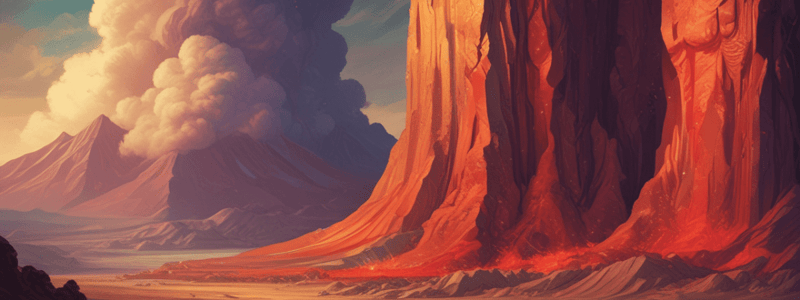Podcast
Questions and Answers
What is the primary way that volcanoes are formed?
What is the primary way that volcanoes are formed?
- The movement of tectonic plates
- The rising of magma from the Earth's interior (correct)
- The cooling of the Earth's crust
- The collision of two tectonic plates
What type of volcano is gently sloping and rounded with a broad base and gentle slopes?
What type of volcano is gently sloping and rounded with a broad base and gentle slopes?
- Shield Volcano (correct)
- Stratovolcano
- Cinder Cone
- Hotspot Volcano
What is the term for the large, rigid slabs of the Earth's lithosphere that fit together like a jigsaw puzzle?
What is the term for the large, rigid slabs of the Earth's lithosphere that fit together like a jigsaw puzzle?
- Tectonic Plates (correct)
- Seismic Zones
- Continental Drift
- Geological Faults
What type of plate boundary is characterized by plates moving apart, with new crust being formed?
What type of plate boundary is characterized by plates moving apart, with new crust being formed?
What is the driving force behind volcanic activity?
What is the driving force behind volcanic activity?
What is the term for an area of volcanic activity that is not located at a plate boundary?
What is the term for an area of volcanic activity that is not located at a plate boundary?
Flashcards are hidden until you start studying
Study Notes
Volcanoes and Tectonic Plates
What are Volcanoes?
- A landform that occurs when magma from the Earth's interior rises to the surface, resulting in eruptions of molten rock, ash, and gas
- Can be found on land and under the ocean
Types of Volcanoes
- Shield Volcanoes: gently sloping, rounded volcanoes with a broad base and gentle slopes
- Formed by the eruption of fluid lava flows
- Examples: Hawaiian Islands, Iceland
- Stratovolcanoes: tall, conical volcanoes with steep slopes
- Formed by a combination of lava flows, ash, and other pyroclastic material
- Examples: Mount St. Helens, Mount Fuji
- Cinder Cones: small, steep-sided volcanoes formed from accumulated ash and cinder
- Examples: Paricutin volcano in Mexico
What are Tectonic Plates?
- Large, rigid slabs of the Earth's lithosphere (outer layer) that fit together like a jigsaw puzzle
- In constant motion, sliding over the more fluid asthenosphere (upper mantle) below
Plate Boundaries
- Divergent Boundaries: where plates move apart, new crust is formed
- Example: Mid-Atlantic Ridge
- Convergent Boundaries: where plates collide, crust is destroyed or thickened
- Example: Andean mountain building
- Transform Boundaries: where plates slide past each other horizontally
- Example: San Andreas Fault
Volcanoes and Plate Tectonics
- Most volcanoes are located at plate boundaries, where the Earth's crust is being stretched or compressed
- The movement of tectonic plates is the driving force behind volcanic activity
- Volcanic arcs form when an oceanic plate is being subducted beneath a continental plate
- Example: Andes mountain range
Hotspots
- Areas of volcanic activity that are not located at plate boundaries
- Thought to be caused by mantle plumes, upwellings of hot rock that rise from the Earth's core-mantle boundary
- Example: Hawaiian Islands
Studying That Suits You
Use AI to generate personalized quizzes and flashcards to suit your learning preferences.




